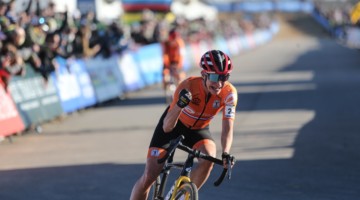Advertisement
EA: It’s difficult for me to say now all the factors that led to a difficult end to my season. It can be a lot of things, being away from home, cultural challenges, being on my own, and that was my choice to be fully integrated. I also got really sick, and was antibiotics for three weeks, and gashed my knee open and needed stitches. I lost a ton of training time, a ton of fitness, and in the end, I was just worn down from a lot of mental energy used to adjust to a foreign environment, and in a five-month span, it can really catch up to you.
But in so many ways I’m so determined and so driven that I refused to pull the ripcord and it was really important for me to stick out that experience until the end. I think back to my last race at the end of February, and I pretty much hated that race, I hated to be riding my bike at that point, and to be turning the pedals. It just shows what we put ourselves through as athletes, and when you have a goal and you really want to chase after it, sometimes you have to drag yourself through a lot of mud in order to get there but you hope to come out on the other side.
CXM: You mentioned a real love for the courses in Europe. What about the courses do you love? The conditions, the technical difficulty, the fans?
EA: Everything! I just think they have unique soil over there. It makes me think of think of the literal translation for cyclocross over there…field riding. It makes me think that to have a Belgian cyclocross experience, you need to have a muddy course, and I’ve definitely ridden in a lot of muddy races over there. If you enjoy the really muddy conditions, you’re in for a field day over there.
One of the things that’s really different is that there’s aren’t all the amateur races earlier in the day, on the same course. It starts with the Juniors, so there’s this flexibility so that course designers can really design for the pros, and a couple of course designers went so far to really design them for the professional men. The men could jump so many more things, I noticed that a lof the women had to dismount for many of these barriers. Sometimes it’s a little frustrating having to dismount 15 times a lap. And sometimes there would be parts of the course where I was genuinely afraid…and had to be 100 percent focused.
CXM: What was it like to be on a Belgian team?
EA: I had about three to four staff members just helping me at the race. A lot of what racing over in Europe is about presentation. One of the things about having a camper is that you emerge from the camper, fully ready, and ready for action. You’re fully dressed, ready to jump on your bike, you’re ready to preview the course. You get fully muddy, you come back, someone takes the bike from your hands, someone picks your shoes up from the ground and rinses them off, and you leave your muddiest clothes outside, tip toe into your camper, completely change your clothes, turn on the heat, settle in for the wait, and then you come back out, your bike is sparkling clean, your shoes have been rinsed, and you go out to race.

Elle Anderson enjoying the Belgian team support, warming up the legs and talking tactics. © Emiel Van den Broek
CXM: So in that sense you had the top-level professional experience?
EA: In that sense, yes. I even had a couple host families that insisted on doing my laundry after a race. I had five kits, and sometimes I’d use all of them on one day.




























